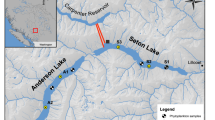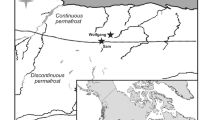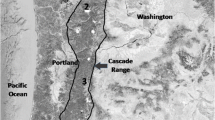Abstract
The physical and chemical limnology of 204 lakes from across the Canadian Arctic Archipelago was examined. Mean summer air temperature did not correlate well with lake chlorophyll levels due to the predominance of ultra-oligotrophic hard-water lakes located in a polar climate. Local geology influences ion budgets and is an important factor in determining pelagic phosphorus availability, carbon cycling and metal concentrations. Ratios of particulate carbon, particulate nitrogen and chlorophyll a indicate that planktonic microorganisms are not always the major producers of organic carbon in arctic lakes. Allochthonous particulate matter contributes significantly to the carbon and phosphorus budgets of small and mid-sized lakes across the Arctic, although the availability of these elements is controlled by many interacting geochemical and biological factors. Phosphorus is generally limiting, however, increases in available phosphorus, nitrogen and carbon are all required to make significant long-term differences in lake productivity. Particulate phosphorus levels can be high in lakes where phosphorus-rich shales or carbonatite bedrock are present. These phosphorus-enriched lakes are found in several areas across the mid-arctic islands, however, only small amounts of this nutrient are available as soluble reactive phosphorus. Although lakes throughout the Arctic are typically ultra-oligotrophic, they still represent an important sink for allochthonous nutrient deposition.
Similar content being viewed by others
References
Alexander, V., C. S. Whalen & K. M. Klingensmith, 1989. Nitrogen cycling in arctic lakes and ponds. Hydrobiologia 172: 165–172.
Allen, H. L., 1971. Primary productivity, chemo-organotrophy, and nutrient interactions of epiphytic algae and bacteria on macrophytes in the littoral of a lake. Ecol. Monogr. 41: 97–127.
Atkinson, D., 2000. Topoclimatic modeling of surface air temperature in the Canadian Arctic Archipelago. PhD thesis, University of Ottawa. Department of Geography. Ottawa, Canada. 266 pp.
Bergmann, M. A. & H. E. Welch, 1985. Spring meltwater mixing in small arctic lakes. Can. J. Fish. aquat. Sci. 42: 1789–1798.
Burnison, B. K., 1980. Modified dimethyl sulfoxide (DMSO) extraction for chlorophyll a analysis of phytoplankton. Can. J. Fish. aquat. Sci. 37: 729–733.
Calvert, S. E., 1983. Sedimentary geochemistry of silica. In Aston, S. R. (ed.), Silicon Geochemistry and Biogeography. Academic Press, N.Y.: pp. 143–186.
Dickman, M. & M. Ouellet, 1987. Limnology of Garrow Lake, NWT, Canada. Polar Record 23: 531–549.
Douglas, M. S. V. & J. P. Smol, 1994. Limnology of high arctic ponds. (Cape Herschel, Ellesmere Island, N.W.T). Arch. Hydrobiol. 131: 401–434.
Douglas, M. S. V., J. P. Smol & W. Jr. Blake, 1994. Marked post-18th century environmental change in high-arctic ecosystems. Science 266: 416–419.
Edlund, S. A. & B. T. Alt, 1989, Regional congruence of vegetation and summer climate patterns in the Queen Elizabeth Islands, Northwest Territories, Canada. Arctic 42: 3–22.
Eilers, J. M., D. H. Landers, A. D. Newell, M. E. Mitch, M. Morisson & J. Ford, 1993. Major ion chemistry of lakes on the Kenai Peninsula, Alaska. Can. J. Fish. aquat. Sci. 50: 816–826. 147
Environment Canada, 1982. Detailed Surface Water Quality Data. Northwest Territories. 1977–1979.
Environment Canada, 1994a. Manual of Analytical Methods: Major Ions and Nutrients, Vol. 1. National Laboratory for Environmental Testing, Canadian Centre for Inland Waters, Burlington, Ontario: 651 pp.
Environment Canada, 1994b. Manual of Analytical Methods: Trace Metals, Vol.2. National Laboratory for Environmental Testing, Canadian Centre for Inland Waters, Burlington, Ontario; 446 pp.
Eppley, R.W.,W. G. Harrison, S.W. Chisholm, & E. Steward, 1977. Particulate organic matter in surface waters off California, and its relation to photosynthesis. J. mar. Res. 35: 671–696.
Fallu, M.-A. & R. Pienitz, 1999. Diatomées lacustres de Jamésie-Hudsonie (Québec) et modèle de reconstitution des concentrations de carbone organique dissous. Ecoscience 6: 603–620.
Faure, G., 1991. Principles and Applications of Inorganic Geochemistry. MacMillan Publ. Co., New York: 626 pp.
Fee, E. J., R. E. Hecky, S. J. Guildford, C. Anema, D. Mathew & K. Hallard, 1988. Phytoplankton primary production and related limnololgical data for lakes and channels in the Mackenzie Delta and lakes on the Tuktoyaktuk Peninsula, N.W.T. Can.Tech. Rep. Fish. aquat. Sci. 1614: 62 pp.
Gajewski, K., P. B. Hamilton & R. McNeely, 1997. A high resolution proxy-climate record from an arctic lake with annuallylaminated sediments on Devon Island, Nunavut, Canada. J. Paleolimnol. 17: 215–225.
Gregory-Eaves, I., J. P. Smol, B. P. Finney, D. R. S. Lean & M.E. Edwards, 2000. Characteristics and variation in lakes along a north-south transect in Alaska. Arch. Hydrobiol. 147: 193–223.
Hamilton, P. B., D. R. S. Lean & M. Poulin, 1994. The physicochemical characteristics of lakes and ponds from the northern regions of Ellesmere Island. In Hamilton, P. B. (ed.), Proceedings of the Fourth Arctic–Antarctic Diatom Symposium (Workshop). Canadian Museum of Nature, Ottawa, Ontario. September 18–21, 1993. Can. Tech. Fish. aquat. Sci. 1957: 57–63.
Hamilton, P. B., K. Gajewski, R. McNeely & D. R. S. Lean, 2000. Physical, chemical and biological characteristics of lakes from the Slidre River basin on Fosheim Peninsula, Ellesmere Island, Nunavut. In Garneau, M. & B. T. Alt (eds), Environmental Responses to Climate Change in the Canadian High Arctic. Geol. Surv. Can. Bull. 529: 235–248.
Hem, J. D., 1972. Chemical factors that influence the availability of iron and manganese in aqueous systems. Bull. Geol. Soc. am. 83: 443–450.
Hobbie, J. E. (ed.), 1980. Arctic Limnology of tundra ponds. Dowden, Hutchinson and Ross Inc. Stroudsburg, PA: 514 pp.
Hobbie, J. E., 1997. History of limnology in Alaska: Expeditions and major projects. In Milner, A. M. & M. W. Oswood (eds), Freshwaters of Alaska – Ecological Syntheses. Springer, Ecological Studies 119, New York: 45–60 pp.
Howard-Williams, C. & W. F. Vincent, 1989. Microbial communities in southern Victoria Land streams (Antarctica) I. Photosynthesis. Hydrobiologia 172: 27–38.
Howard-Williams, C., J. C. Priscu & W. F. Vincent, 1989. Nitrogen dynamics in two Antarctic streams. Hydrobiologia 172: 51–61.
Hutchinson, G. E., 1957. A Treatise on Limnology. Volume 1, Geography, Physics and Chemistry.John Wiley and Sons, London: 1015 pp.
Jeffrey, S. W. & G. F. Humphrey, 1975. New spectrophotometric equations for determining chlorophylls a, b, c1 and c2 in higher plants, algae and natural phytoplankton. Biochem. Physiol. Plantz. 167: 191–194.
Kalff, J. & H. E. Welch, 1974. Phytoplankton production in Char Lake, a natural polar lake, and in Meretta Lake, a polluted polar lake, Cornwallis Island, Northwest Territories. J. Fish. Res. Bd Can. 31: 621–636.
Kling, G. W., W. J. O'Brien, M. C. Miller & A. E. Hershey, 1992. The biogeochemistry and zoogeography of lakes and rivers in arctic Alaska. Hydrobiologia 240: 1–14.
Koski-Vahala, J., H. Hartikainen & P. Tallberg, 2001. Phosphorus mobilization from various sediment pools in response to increased pH and silicate concentration.J. envir. Qual. 30: 546–552.
Lamoureaux, S. F. & R. S. Bradley, 1996. A late Holocene varved sediment record of environmental change from northern Ellesmere Island, Canada. J. Paleolimnol. 16: 239–255.
Levinson, A. A., 1974. Introduction to exploration geochemistry. Applied Publishing Ltd., Calgary: 612 pp.
Lewkowicz, A. G., 1991. Climate change and the permafrost landscape. In Arctic environments, past, present and future. Woo, M. K. & D. J. Gregor (eds), Proceedings of a Symposium held at McMaster University, Hamilton, Ontario. 91–104 pp.
Lim, D. S. S., M. S. V. Douglas, J. P. Smol & D. R. S. Lean, 2001. Physical and chemical limnological characteristics of 38 lakes and ponds on Bathurst Island, Nunavut, Canadian High Arctic. Int. Rev. ges. Hydrobiol. 86: 1–22.
Livingstone, D. A., 1966. Alaska, Yukon, Northwest Territories and Greenland. In Frey, D. G. (ed.), Limnology in North America. University of Wisconsin Press, Madison, Wis: 559–574 pp.
Mineral and Metals Sector and National Energy Board, 1997. 47th edition, Geological Survey of Canada, Map 900A, Scale 1:6 000 000.
McNeely, R. & W. D. Gummer, 1984. A reconnaissance survey of the environmental chemistry in east-central Ellesmere Island, N.W.T. Arctic 37: 210–223.
Pick, F. R., 1987, Carbohydrate and protein content of lake seston in relation to plankton nutrient deficiency. Can. J. Fish. aquat. Sci. 44: 2095–2101.
Pienitz, R., J. P. Smol & D. R. S. Lean, 1997a. Physical and chemical limnology of 59 lakes located between the southern Yukon and the Tuktoyaktuk Peninsula, Northwest Territories (Canada). Can. J. Fish. aquat. Sci. 54: 330–346.
Pienitz, R., J. P. Smol & D. R. S. Lean, 1997b. Physical and chemical limnology of 24 lakes located between Yellowknife and Contwoyto Lake, Northwest Territories (Canada). Can. J. Fish. aquat. Sci. 54: 347–358.
Pienitz, R. & W. F. Vincent, 2000. Effect of climate change relative to ozone depletion on UV exposure in subarctic lakes. Nature 404: 484–487.
Rouse, W. R., M. S. V. Douglas, R. E. Hecky, A. A. Hershey, G. W. Kling, L. Lesack, P. Marsh, M. McDonald, B. J. Nicholson, N.T. Roulet & J. P. Smol, 1997. Effects of climate change on the freshwaters of arctic and subarctic North America. Hydrological Processes 11: 873–902.
Rühland, K. & J. P. Smol, 1998. Limnological characteristics of 70 lakes spanning arctic treeline from Coronation Gulf to Great Slave Lake in the central Northwest Territories, Canada. Int. Rev. Hydrobiol. 83:183–203.
Satoh, Y., V. Alexander & E. Takahashi, 1992. Dissolved organic carbon (DOC) and some chemical profiles of various Alaskan lakes in summer. Jap. J. Limnol. 53: 207–216.
Schindler, D. W., H. E. Welch, J. Kalff, G. J. Brunskill & N. Kritsch, 1974a. Physical and chemical limnology of Char Lake, Cornwallis Island (75 N Lat.). J. Fish. Res. Bd Can. 31: 585–607.
Schindler, D. W., J. Kalff, H. E. Welch, G. J. Brunskill, H. Kling & N. Kritsch, 1974b. Eutrophication in the High Arctic – Meretta Lake, Cornwallis Island (75 N. Lat.). J. Fish. Res. Bd Can. 31: 647–662.
Scully, N. M. & D. R. S. Lean, 1994. The attenuation of ultraviolet radiation in temperate lakes. Arch. Hydrobiol. Beih Ergebn. Limnol. 43: 135–144.
Shortreed, K. S. & J. G. Stockner, 1986. Trophic status of 19 subarctic lakes in the Yukon Territory. Can J. Fish aquat. Sci. 43: 797–805.
Stewart, A. J. & R. G. Wetzel, 1981. Asymmetrical relationships between absorbance, fluorencence, and dissolved organic carbon. Limnol. Oceanogr. 26: 590–597.
Stewart, D. B., & G. MacDonald, 1981. An aquatic resources survey of Devon, Cornwallis, Somerset and northern Baffin Islands, District of Franklin, Northwest Territories, 1980. Indian and Northern Affairs Canada. Environmental Studies No. 20. 84 pp.
Stewart, D. B. & L. M. J. Bernier, 1983. An aquatic resource survey of Victoria and King William Islands and the northeastern District of Keewatin, Northwest Territories. Indian and Northern Affairs Canada. Northern Environment Branch and Environment Canada. Lands Directorate. Land Use Information Series Background Report No 3. 124 pp.
Stewart, D. B. & L. M. J. Bernier, 1984. An aquatic resource survey of Melville Peninsula, Southampton Island, and the northeastern District of Keewatin, Northwest Territories. Indian and Northern Affairs Canada. Northern Environment Branch and Environment Canada. Lands Directorate. Land Use Information Series Background Report No 4. 144 pp.
Stewart, D. B. & L. M. J. Bernier, 1988a. An aquatic resource survey of southern Baffin Island, District of Franklin, Northwest Territories. Indian and Northern Affairs Canada. Northern Environment Branch and Environment Canada. Lands Directorate. Land Use Information Series Background Report No 5. 121 pp.
Stewart, D. B. & L.M. J. Bernier, 1988b. An aquatic resource survey of central Baffin Island, District of Franklin, Northwest Territories. Indian and Northern Affairs Canada. Northern Environment Branch and Environment Canada. Lands Directorate. Land Use Information Series Background Report No 8. 129 pp.
Turekian, K. K. & K. H. Wedepohl, 1961.Distribution of the elements in some major units of the earth's crust. Geol. Soc. am. Bull. 72: 175–192.
Vincent, W. F. & R. Pienitz, 1996. Sensitivity of high-latitude freshwater ecosystems to global change: temperature and solar ultraviolet radiation. Geosci. Can. 23: 231–236.
Welch, H. E. & J. A. Legault, 1986. Precipitation chemistry and chemical limnology of fertilized and natural lakes at Saqvaqjuac, N.W.T. Can. J. Fish. aquat. Sci. 43: 1104–1134.
Welch, H. E., D. C. G. Muir, B. N. Billeck, W. L. Lockhart, G.J. Brunskill, H. J. Kling, M. P. Olson & R. M. Lemoine, 1991 Brown Snow: Long range transport event in the Canadian Arctic. Environ. Sci. Technol. 25: 280–286.
Wetzel, R. G., 1971. The role of carbon in hard-water marl lakes. In Likens, G. E. (ed.), Nutrients and Eutrophication: the Limitingnutrient Controversy. Special Symposium Amer. Soc. Limnol. Oceanogr. 1: 84–91.
Wetzel, R. G., 1983. Limnology.W.B. Saunders Company, Toronto: 743 pp.
Whalen, S. C. & J. C. Cornwell, 1985. Nitrogen, phosphorus and organic carbon cycling in an arctic lake. Can. J. Fish. aquat. Sci. 42: 797–808.
Wheeler, J. O., P. F. Hoffman, K. D. Card, A. Davidson, B. V. Sanford, A. V. Okulitch & W. R. Roest, 1997. Geological Map of Canada. Map D1860A, CD-ROM version 1.0. Natural Resources Canada, Ottawa.
Woo, M. K., 1991. Arctic streamflow. InWoo, M. K. & D. J. Gregor (eds), Arctic Environments: Past, Present & Future. Proceedings of a Symposium held atMcMaster University, Nov. 14–15, 1991. Hamilton, Ontario: 105–111 pp.
Author information
Authors and Affiliations
Rights and permissions
About this article
Cite this article
Hamilton, P.B., Gajewski, K., Atkinson, D.E. et al. Physical and chemical limnology of 204 lakes from the Canadian Arctic Archipelago. Hydrobiologia 457, 133–148 (2001). https://doi.org/10.1023/A:1012275316543
Issue Date:
DOI: https://doi.org/10.1023/A:1012275316543




